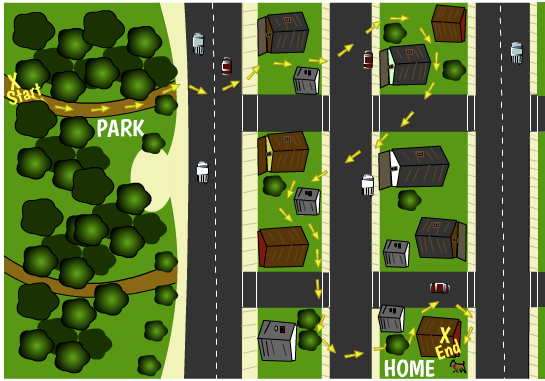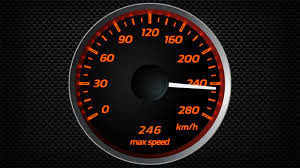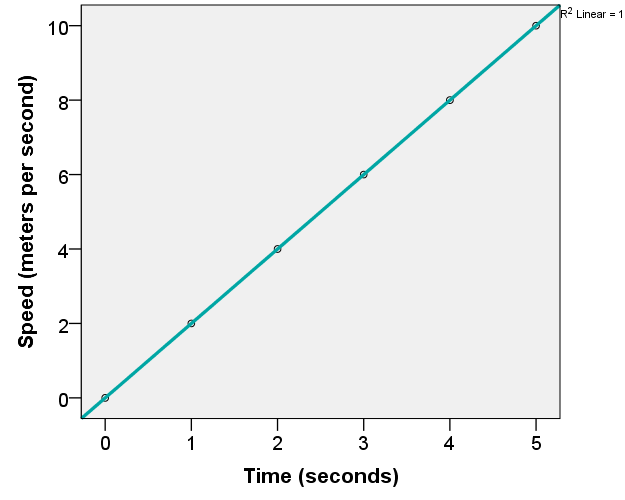

Speed, velocity, and acceleration are related to each other. Each of these can be measured at an instant (or a point in time) or as averages over a given time interval (for example, a few seconds or minutes). We'll start with the simplest of these quantities, speed...
First, what is speed? The Speed of an object is simply how fast the object is moving.
We can calculate (a) the speed of an object across some time, or the average speed, or (b) the speed of an object at a moment in time: the "instantaneous" speed.
Average speed. The average speed of an object is defined as the distance the object travels divided by the time it takes to travel that distance:
For example, a car drives a distance of 10,000 meters (6.21 miles) in 1,000 seconds (16.67 minutes). The car's average speed can be calculated as:
We can also calculate the time it takes something to move a certain distance, if we know the distance it travels and its average speed during that time:

For example, a lost dog runs a distance of 3,000 meters looking for his home. His path is shown in the picture above. The dog's high-tech collar shows that his average speed during this time was 3 m/s. The (happy) owner calculated the time the dog took to find his home using this equation:
Instantaneous speed. The instantaneous speed of an object is its speed (for example, in meters per second) at a specific moment in time. The speedometer in a car measures the instantaneous speed of the car (in miles per hour or kilometers per hour) at any moment. Because it is measuring the instantaneous speed of the car, the speed can be continually changing.
The speedometer in a car measures the instantaneous speed of the car (in miles or kilometers per hour), or the speed of the car at any moment. The picture below shows a speedometer (in kilometers per hour, or km/h).

To simplify, in this unit, the following definitions of velocity and acceleration will apply to motion in a straight line without changing direction.
What is Velocity?
The velocity of an object includes both its speed and the direction it is moving. Because it has both a numerical value and a direction, velocity is said to be a "vector" quantity. (See Vector vs. Scalar Quantities for more information about vectors.)
The instantaneous velocity of an object is its speed (for example, meters per second) and direction it is moving at a specific moment in time. The instantaneous speed in combination with the direction the object is moving at a given time is equal to its instantaneous velocity (at that point in time).
The picture below shows a speedometer (in kilometers per hour, or km/h). The car is moving due east at the moment this picture was taken. So, we would say that the instantaneous velocity of the car at this moment is 245 km/h due east.

What is acceleration? An object is accelerating if its velocity is changing. Remember: velocity is a vector quantity, which means it has both a magnitude (speed) and a direction (the direction it is moving).
So, an object is accelerating if either its SPEED is changing or if the DIRECTION the object is moving changes. Or both!
Acceleration (average). Just like speed and velocity, we can calculate either average acceleration (over some time) or the instantaneous acceleration (at a moment in time).
The average acceleration of an object is defined as the change in velocity of an object divided by the time it took for the velocity to change:
If an object is moving in a straight line in a given direction, the magnitude of the acceleration of the object is equal to the change in its speed over the time it takes for that change in speed as well of the direction of its change in speed:
In general, when something is moving in a straight line and its speed is increasing, its acceleration is in the same direction of its motion or velocity.
Example 1: Speeding up/Accelerating: A car initially at a stop light accelerates in a straight line eastward and reaches a speed of 20 m/s (about 45 miles per hour) in 10 seconds.
This means that each second, the speed of the car increases by 2 m/s.
So after one second, the car is travelling at 2 m/s. After two seconds, the car is travelling at 4 m/s. After three seconds, the car is travelling at 6 m/s, etc.
This relationship between time and speed for a car accelerating at a constant 2 m/s2 is shown in the graph below:

Example 2: constant speed. A child on a sled rides straight down a hill with a 15 degree slope. When the child gets a running start and falls on the sled at time-1, the child is moving at 5 m/s (about 11 mph). Ten seconds later (time-2), the child is still moving at 5 m/s sliding down the hill on the sled. What is the child's average acceleration between time-1 and time-2?
The child's (average) acceleration can be calculated as:
The child's speed has not changed over this period of time, so the child's (average) acceleration (over this time interval) is zero.
Example 3: Slowing down/decelerating. A baseball player is running from third base at 5 m/s when he slides into home base and stops 1 second later.
The baseball player's average acceleration can be calculated as:
This negative value of acceleration can also be expressed as: 5 m/s (from home plate toward 3rd base). In other words, the direction of the player's acceleration is opposite the direction of his motion!
In general, when something is moving in a straight line and slowing down, its acceleration is in the direction opposite of its motion or velocity.
Calculating final speed from acceleration. We can also calculate the final speed of an object if we know its initial speed and its acceleration.
Example 4: After hockey practice, the team takes off their helmets and puts them in a box in the middle of the hockey rink. When all the helmets are in the box, the coach pushes on the box using his hockey stick, which accelerates at a constant 2 m/s2 from rest, for 2 seconds. What is the final speed of the box after 2 seconds?
Using the definition of acceleration:
We can re-write this equation by multiplying each side by time:
Then we add initial velocity to each side:
Reversing the sides of the equation:
Solving for final velocity: